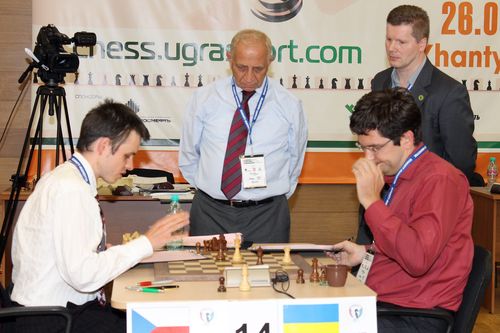Ethics at 2011 World Cup

While watching the 2011 World Cup broadcast, I was particularly intrigued with the Alexander Moiseenko and David Navara because they had reached a textbook ending… queen versus rook and pawn. Navara (the stronger side) had shown how to wrest the remaining pawn away and then set sights on executing the well-known endgame problem.
After a bit a clumsiness, he arrived at a winning position, but before making the final move, he extended his hand. As I watched I assumed that Moiseenko had resigned, but when result was posted as ½-½, I simply thought it was a mistake. Later I found that Navara had indeed offered a draw because of an earlier incident.

The result of the game raised a lot of eyebrows after Navara had spent 40 moves to get a winning position. Photos from https://chess.ugrasport.com/.
Unbeknownst to many something had already occurred on move 35. Navara had intended to move his bishop accidentally touched his king. FIDE rules allow for this and Navara actually could ask for an appeal had Moiseenko continued to press. However, after a brief exchange, Moiseenko realized that the touch was an accident since moving the king would allow the capture of a free piece. The game continued and after getting a winning position, Navara offered the draw.
It was a sporting end to a fantastic and instructive battle. Many cited that Navara was covered by the following FIDE rule Article 4… (emphasis mine):
4.2 Provided that he first expresses his intention (for example by saying „j’adoube“ or “I adjust”), the player having the move may adjust one or more pieces on their squares.
4.3 Except as providedin Article 4.2, if the player having the move deliberately touches on the chessboard:
a. one or more of his own pieces, he must move the first piece touched which can be moved
b. one or more of his opponent’s pieces, he must capture the first piece touched which can be captured
c. one piece of each colour, he must capture the opponent’s piece with his piece or, if this is illegal, move or capture the first piece touched which can be moved or captured. If it is unclear, whether the player’s own piece or his opponent’s was touched first, the player’s own piece shall be considered to have been touched before his opponent’s. (see rule)
There are many players who would not have been so sporting, simply taken the point and gone to dinner. Such a “touch case” soured the 2006 Olympiad match between Jamaica and Finland when GM Tomi Nyback of Finland intentionally grabbed his king, hovered over a square, saw a stronger move, placed the king back and then moved his bishop. He later claimed he was adjusting the king. Shane Matthews was distraught at this poor sportsmanship, but lost the appeal because he signed the scoresheets.
Perhaps this game will be a lesson that many will discuss for many years to come. Enjoy game!
